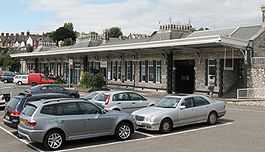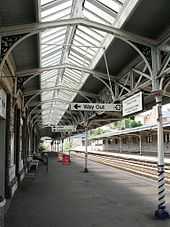Teignmouth railway station
| Teignmouth | |
|---|---|
 | |
| Location | |
| Place | Teignmouth, Devon |
| Local authority | Teignbridge |
| Coordinates | 50°32′53″N 3°29′40″W / 50.54814°N 3.49452°WCoordinates: 50°32′53″N 3°29′40″W / 50.54814°N 3.49452°W |
| Grid reference | SX942731 |
| Operations | |
| Station code | TGM |
| Managed by | First Great Western |
| Number of platforms | 2 |
|
Live arrivals/departures, station information and onward connections from National Rail Enquiries | |
| Annual rail passenger usage* | |
| 2002/03 | 0.286 million |
| 2004/05 |
|
| 2005/06 |
|
| 2006/07 |
|
| 2007/08 |
|
| 2008/09 |
|
| 2009/10 |
|
| 2010/11 |
|
| 2011/12 |
|
| 2012/13 |
|
| 2013/14 |
|
| History | |
| Original company | South Devon Railway |
| Pre-grouping | Great Western Railway |
| Post-grouping | Great Western Railway |
| Opened | 1846 |
| Rebuilt | 1895 |
| National Rail – UK railway stations | |
| * Annual estimated passenger usage based on sales of tickets in stated financial year(s) which end or originate at Teignmouth from Office of Rail Regulation statistics. Methodology may vary year on year. | |
| UK Railways portal | |
Teignmouth railway station is on the Exeter to Plymouth line and serves the town of Teignmouth, Devon, England. It is operated by First Great Western.
History
The station was opened by the South Devon Railway Company on 30 May 1846 as the terminus of its first section from Exeter.[1] The line was extended to Newton Abbot on 31 December 1846. The single platform was augmented by a second one late in 1848. At this time it was a 7 ft (2,134 mm) broad gauge railway.
Trains were worked from Exeter by atmospheric power from 13 September 1847 and these were extended to Newton Abbot from 17 December 1847 until all the atmospheric trains were suspended on 9 September 1848.[2] The atmospheric engine house was situated adjacent to the platform on the side furthest from the town, the area then being used as permanent way workshops until about 1876.
The South Devon Railway was amalgamated into the Great Western Railway on 1 February 1876. When first built the station was situated between two tunnels but the West Tunnel was opened out by June 1881 and the Eastcliffe Tunnel leading to the Sea Wall was removed by 1884, when the distinctive lattice girder bridge at the end of the Sea Wall was installed.

On 20 May 1892 the line was converted to 4 ft 8 1⁄2 in (1,435 mm) standard gauge. The station was completely rebuilt soon after, the work being completed early in 1895. It now had a similar scale of facilities as those found at other big West Country resorts which had new stations during the last quarter of the century, Torquay and Weston-super-Mare. To accommodate longer trains the westbound platform was extended in 1938 and could then handle 15 coach trains, but the opposite platform could not be extended due to the entrance to the goods yard.
The Great Western Railway in turn was nationalised into British Railways on 1 January 1948. General goods traffic at Teignmouth ceased on 14 June 1965 but coal traffic continued to be handled until 4 December 1967.[3] This allowed the extension of the second platform to the length of Inter City trains, although this did not happen until 1981. The signal box, which was built at the west end of the westbound platform in 1896, was closed on 14 November 1986 when the new Panel Signal Box at Exeter took over control of the line.
Description
The station is situated near the edge of the town centre and a short walk from the beach and South West Coast Path.
It is constructed out of dark grey rubble stone. The main entrance and booking office is on the platform used by trains to Paignton. All the main facilities, including a café, are situated on this platform. When the booking office is closed access to the station is through the gates adjacent to the wide footbridge which links the main platform to the one used by trains towards Dawlish and Exeter. It is the second busiest station on the Riviera Line after Newton Abbot.
Services

Teignmouth is served by First Great Western local trains in both directions on an approximately hourly basis during the day - more frequent at peak times. Most trains run between Exmouth and Paignton; on Sundays the service is less frequent and most trains only run between Exeter St Davids and Paignton.[4] The line from Exeter St Davids through Teignmouth to Paignton is marketed as the "Riviera Line".
A few First Great Western trains from Bristol or from London Paddington station also call at Teignmouth[4] as do CrossCountry services from the North of England.[5] Most of these services, including the Torbay Express from Paddington, continue to Paignton but a few run instead to Plymouth and even Penzance. At other times passengers travelling east or north catch a local train and change into main line trains at Exeter St Davids, or at Newton Abbot if travelling westwards.
| Preceding station | |
Following station | ||
|---|---|---|---|---|
| Dawlish | First Great Western Riviera Line |
Newton Abbot | ||
| CrossCountry Cornwall-Scotland |
||||
References
| Wikimedia Commons has media related to Teignmouth railway station. |
- ↑ Gregory, R H (1982). The South Devon Railway. Salisbury: Oakwood Press. ISBN 0-85361-286-2.
- ↑ Kay, Peter (1991). Exeter - Newton Abbot: A Railway History. Sheffield: Platform 5 Publishing. ISBN 1-872524-42-7.
- ↑ Oakley, Mike (2007). Devon Railway Stations. Wimbourne: The Dovecote Press. ISBN 978-1-904349-55-6.
- ↑ 4.0 4.1 "National Rail Timetable 135 (May 2013)" (PDF). Network Rail.
- ↑ "National Rail Timetable 51 (May 2013)" (PDF). Network Rail.
Further reading
- Beck, Keith; Copsey, John (1990). The Great Western in South Devon. Didcot: Wild Swan Publication. ISBN 0-906867-90-8.
- Cooke, RA (1984). Track Layout Diagrams of the GWR and BR WR, Section 14: South Devon. Harwell: RA Cooke.
| This station offers access to the South West Coast Path | |
|---|---|
| Distance to path | 0.25 miles (0.40 km) |
| Next station anticlockwise | Dawlish 3 miles (5 km) |
| Next station clockwise | Torquay 11 miles (18 km) |
| ||||||||||||||||||||||||||||||||||||||||||||||||